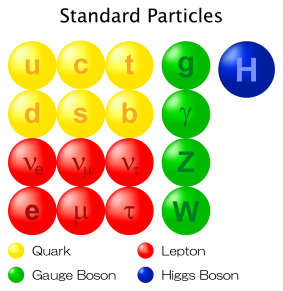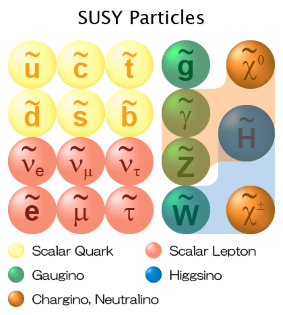Search for Supersymmetic Particles
Several new theoretical frameworks that surpass the currently experimentally confirmed particle physics have been proposed. One of these is called “Supersymmetry (SUSY)”. This theory is built on the assumption of an equal symmetry between fermions (particles with half-integer spins) and bosons (particles with integer spins). The currently established Standard Model of particle physics is based on fermions with spin 1/2, such as quarks and leptons, gauge bosons that mediate forces (spin 1, except for the graviton which has spin 2), and the Higgs particle (spin 0), whose existence is almost certain but has not yet been discovered. (Figure 1) Supersymmetry theory posits the existence of “supersymmetric particles” that interchange fermions and bosons in addition to these Standard Model particles. Specifically, it suggests the existence of spin 0 scalar quarks and scalar leptons for the fermions (quarks and leptons), and spin 1/2 gauginos and higgsinos for the gauge bosons and the Higgs particle. (Figure 2) When we think of “symmetry”, spatial symmetries like mirror reflection and rotation come to mind. However, in the world of particle physics, symmetries such as time-reversal symmetry (interchanging the progression of time) and charge-conjugation symmetry (interchanging positive and negative charges) also play important roles. In contrast, supersymmetry is a theoretically proposed symmetry, and it is still unknown whether it truly exists. There are compelling reasons for introducing a new symmetry, one of which is that assuming supersymmetry provides an answer to the “hierarchy problem” in particle physics. The hierarchy problem is related to why gravity is so much weaker than the other forces (a difference of 16 orders of magnitude in terms of energy).
In the current CDF experiment, we searched for particles known as the chargino \(\tilde{\chi}^{\pm}\) and the neutralino \(\tilde{\chi}^0\) among these supersymmetric particles. The chargino represents the mass eigenstate resulting from the quantum mixing of the charged higgsino \(\tilde{H}^{\pm}\) and the wino \(\tilde{W}^{\pm}\). Similarly, the neutralino is the mass eigenstate resulting from the quantum mixing of the neutral higgsino \(\tilde{H}^0\), the photino \(\tilde{\gamma}\), and the zino \(\tilde{Z}\). As shown in Figure 3, charginos and neutralinos are pair-produced by proton-antiproton collisions (microscopically quark-antiquark collisions), and these particles decay with certain probabilities as indicated by the following equations:
\begin{align*}
p\bar{p} &\rightarrow \tilde{\chi}^{\pm}_1 \tilde{\chi}^0_2 + X \\
\tilde{\chi}^{\pm}_1 &\rightarrow \ell^{\pm}\nu \tilde{\chi}^0_1 \\
\tilde{\chi}^{0}_2 &\rightarrow \ell^+\ell^- \tilde{\chi}^0_1 \;\;\;\;(\ell = e, \mu, \tau)
\end{align*}
As shown in the above reactions, this reaction has the unusual feature of producing “three” high-momentum charged leptons in the final state. Additionally, \(\tilde{\chi}^0_1\) is the lightest supersymmetric particle (LSP), electrically neutral, and stable (does not decay). Therefore, like neutrinos (ν), it leaves no trace in the detector, resulting in an event with a severe energy imbalance (“missing energy”). In this analysis, we searched for chargino-neutralino pair-production events by using these “three leptons” and “missing energy” as signals. If supersymmetric particles were observed, the number of these “signal” events should exceed the total number of background events predicted by the Standard Model. The analysis of proton-antiproton collision data with an integrated luminosity of 2.0 fb-1 showed that while the expected total background was 6.4±1.2, seven events were actually observed. Figure 3 shows an example of the missing energy distribution. The histogram represents the theoretical prediction, and the points with error bars represent the experimental data. Since the observed total background matches the prediction within the margin of error, we were unfortunately unable to discover chargino-neutralino pair production this time. However, from this “non-discovery”, we can calculate the upper limit of the production cross-section for supersymmetric particles. Figure 4 shows the chargino-neutralino pair-production cross-section as a function of chargino mass. The red line represents the theoretical prediction, and the black line represents the upper limit obtained from the experiment. Since the theoretical value exceeds the upper limit from the experiment for chargino masses below 140 GeV/c2, this region cannot exist, meaning the chargino mass must be greater than 140 GeV/c2. As we accumulate more data, the sensitivity to higher mass regions will improve.





